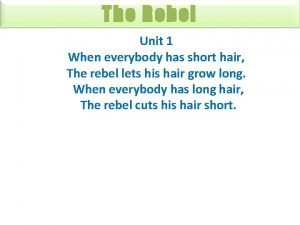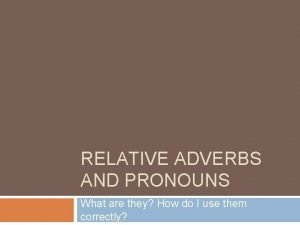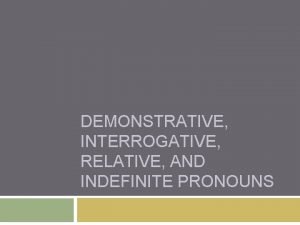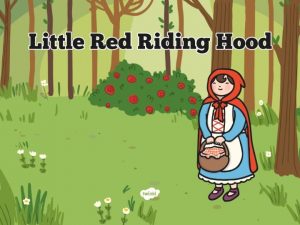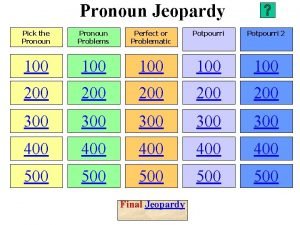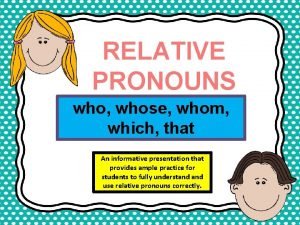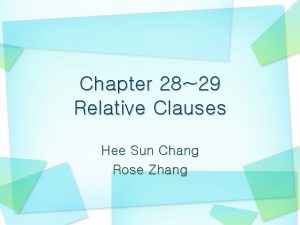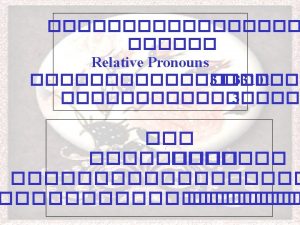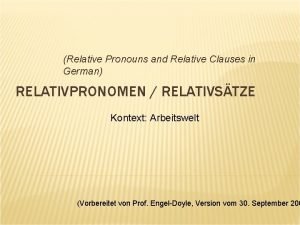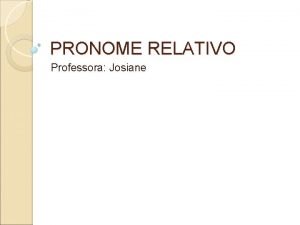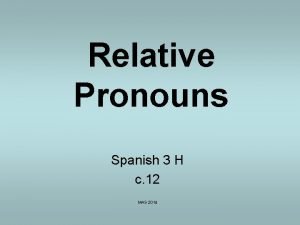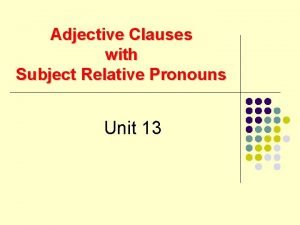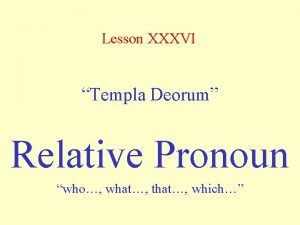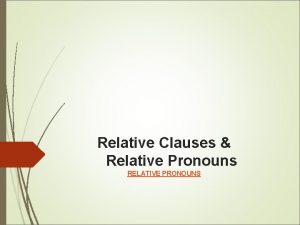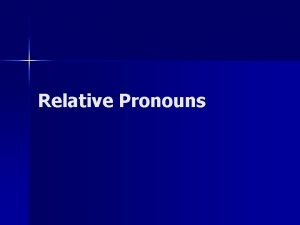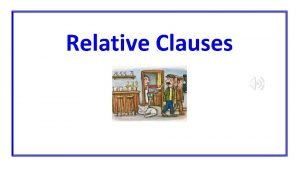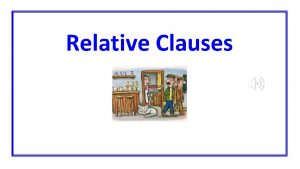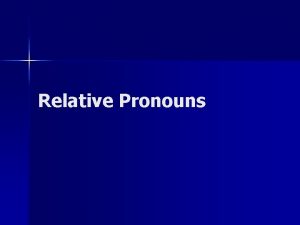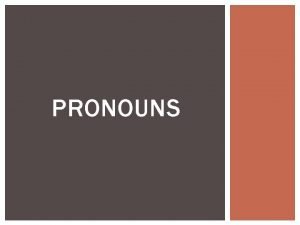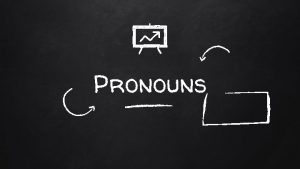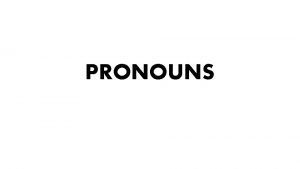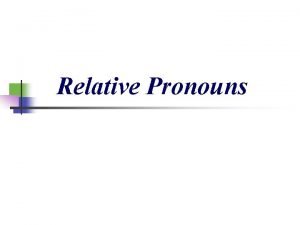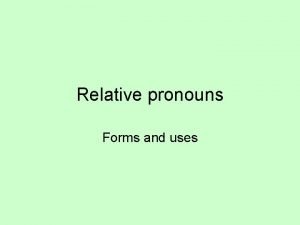Relative Pronouns Meg is a girl Meg likes




















- Slides: 20

Relative Pronouns

Meg is a girl. Meg likes ice cream. We can use a relative pronoun to make the sentences above into one sentence. Meg is a girl who likes ice cream. Click on the link below to hear a song about relative pronouns. Relative Pronouns Song - You. Tube

A relative pronoun is a pronoun that introduces a relative clause. Relative pronouns “relate” to the word that it modifies or describes. We use relative pronouns after a noun to make it clear which person or thing we are talking about. There are five relative pronouns that we are going to focus on: who, whom, whose, which, and that.

Watch a short video to help understand when to use “who” and “whom”. Who or Whom Video

!!! w vie w No , re s ’ let Who is generally only used for people. Look at the following examples. • The girl ____ won the poster contest is in third grade. • The girl is in 3 rd grade. She won the poster contest. • The girl who won the poster contest is in 3 rd grade. he / she = who

Whom is generally only use for people. Whom is not used very often. “Whom” is more formal than “who” and is often omitted when speaking. Look at the following examples. • • • She had three children, all of _______ went to Georgia Southern University. She had three children. All of them went to Georgia Southern University. She had three children, all of whom went to Georgia Southern University. Him / her / them = whom • • • We sometimes use whom as the object of a verb or preposition. This is Mrs. Garcia, whom you met at Open House. This is Mrs. Garcia’s sister, with whom I talked to over the phone. • When whom is used with a preposition, the preposition can be at the beginning or end of the clause. I have an aunt in Ireland, from whom I get my red hair. I have an aunt in Ireland, whom I get my red hair from. • •

who Mr. Potter is the teacher ______ likes coffee. whom Mandy is the girl with _______ I play softball. whom who is now thirteen, just had a birthday. Jordan, _______ whom Independent Practice

Watch the video clip on relative pronouns. “RELATIVE” PRONOUNS

Josh is a boy who loves to play video games. He likes to stay inside when it is raining and play all day long. Who is the relative pronouns describing the boy. Who begins the relative clause “who loves to play video games”.

Who is generally only use for people. Look at the following examples. • The girl ____ won the poster contest is in third grade. • The girl is in 3 rd grade. She won the poster contest. • The girl who won the poster contest is in 3 rd grade. he / she = who

Whose is the only relative pronoun to show possession or ownership! Look at the following examples. • The man whose briefcase is on the seat left in a hurry. • The woman whose hair was in a mess is in the restroom.

whose Students ______ parents are here get a homework pass. whose who Mark and Jake are the boys _____ went to the office for a whose prize. whose The police are looking for the car ______ owner ran the stop sign and caused the crash. whose Independent Practice

Are all of these correct? 1. The man who has on the sunglasses is my father. 2. The boy whose phone just rang is my brother. 3. The woman whose has on the red scarf is my mother. Go to the next slide to see if you are correct.

1. The man who has on the sunglasses is my father. 2. The boy whose phone just rang is my brother. 3. The woman whose has on the red scarf is my mother. Number 3 should say “The woman who has on the red scarf is my mother. ”

Let’s review!!! What are relative pronouns? How many can you name?

Which tells more about things. It is used when the clause added is unnecessary or nonessential to the sentences understanding. Jacob went to the movies, which started at three o’clock. Ann ate a chocolate covered donut, which is full of sugar. • Notice the comma before the word which.

That tells more about people or things. It is used when the clause added is necessary or essential to the sentence. The pants that Tyler wore are too short. Evelyn can not eat foods that contain too much sugar. • Since the clause is essential, no comma is necessary.

Who is generally only use for people. • The girl ____ won the poster contest is in third grade. • The girl is in 3 rd grade. She won the poster contest. • The girl who won the poster contest is in 3 rd grade. he / she = who

who interviewed you is my boss. The woman _______ who which She is wearing the kind of dress _____ that my mother would who that approve of. which is by the wall, needs repairing. The couch, _______ that which Independent Practice Complete the independent practice sheet.

Watch the video clip on relative pronouns. “RELATIVE” PRONOUNS
 When everybody has short hair what does the rebel do answer
When everybody has short hair what does the rebel do answer Relative adverb
Relative adverb Relative clauses and relative pronouns stage 15
Relative clauses and relative pronouns stage 15 Types of relative clauses
Types of relative clauses Possessive and interrogative pronouns
Possessive and interrogative pronouns Indefinite and relative pronouns
Indefinite and relative pronouns Girl and boy xxxx
Girl and boy xxxx On her way to grandmother's house she met a wolf
On her way to grandmother's house she met a wolf Stone girl bone girl
Stone girl bone girl Conditional frequencies
Conditional frequencies Subject and object pronouns jeopardy
Subject and object pronouns jeopardy Who is babysitting whom
Who is babysitting whom Whats a relative pronoun
Whats a relative pronoun Decide whether the relative pronouns must be used or not
Decide whether the relative pronouns must be used or not Was sind relative pronouns
Was sind relative pronouns O que é pronomes relativos
O que é pronomes relativos Relative pronouns exemplos
Relative pronouns exemplos Spanish relative pronouns
Spanish relative pronouns Relative dependent clause
Relative dependent clause Adjective clauses with object relative pronouns
Adjective clauses with object relative pronouns Templa deorum
Templa deorum
